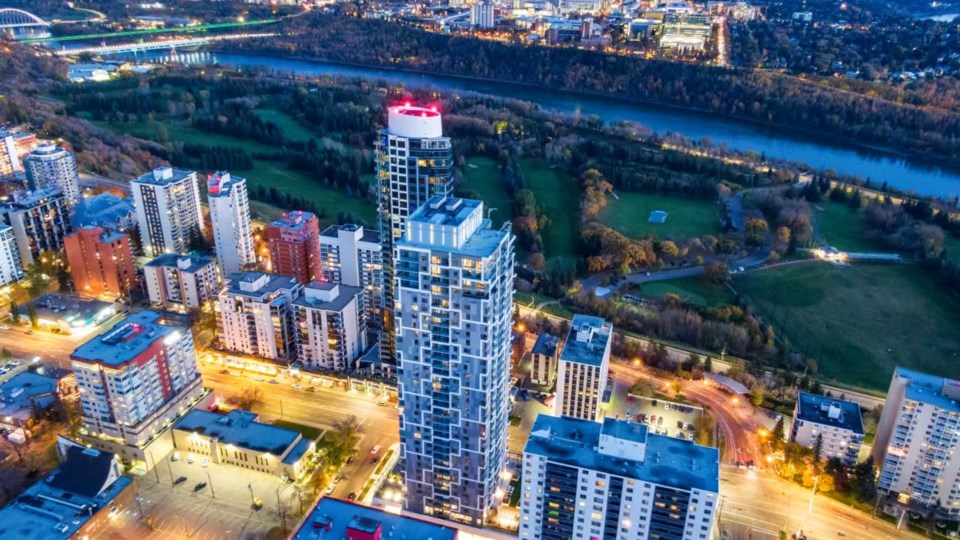The fastest population growth in more than 20 years and a diversified economy are driving Edmonton’s real estate market to new heights.
“Edmonton is the darling of the country right now, and you’re seeing investment from large, private outfits,” said Jandip Deol, a principal focused on multi-family assets in the Edmonton office of real estate services firm Avison Young (Canada) Inc. “They’re all eyes on Edmonton right now.”
Deol says strong population growth – reckoned by the city as the strongest since 2002 – means landlords are seeing record rates and no need to offer incentives to fill up buildings.
The Switch, a 285-unit rental project by Vancouver-based Qualico Properties adjacent to Rogers Place in Edmonton’s downtown ICE District, is close to lease up and, according to Deol, is “performing quite well.” It follows the recent lease-up of Citizen on Jasper, a 344-unit tower built by Toronto’s One Properties.
Canada Mortgage and Housing Corp.’s annual rental market survey pegged vacancies in Edmonton’s purpose-built rental stock at 3.1 per cent last fall, while an analysis of Rentals.ca data by analytics firm Urbanation Inc. singles out Edmonton as the most resilient major market in Canada.
During the 12 months ended June 30, Edmonton saw apartment rents rise nearly one per cent to $1,573 per month, while Calgary, Vancouver and Toronto saw rents decline sharply. When tallied versus three years ago, rents in Edmonton have increased 32 per cent as population grew by 11 per cent.
“Affordability is the key piece,” Deol said. “[You’re] able to raise a family in an affordable environment, in an affordable city, where you have disposable income to enjoy the city.”
The benefits aren’t just being felt in the housing market, but in other sectors, too.
“It’s driving investment activity, it’s driving long-term stability in suburban markets, and it’s giving investors lots of confidence to deploy confidence there,” Deol said.
Avison Young’s review of the Edmonton investment market notes $4.8 billion in investment transactions in the city last year, up 30 per cent from $3.7 billion a year earlier. The first quarter of 2025 shows no let-up, with $1.5 billion in transactions – a pace that, if sustained, puts the market on track to exceed last year’s strong showing.
While multi-family deals have been the clear leader, the sector isn’t alone. Residential land has also seen strong demand, with several large acquisitions taking place since the second half of 2024.
“Developers are actively pursuing raw suburban land to meet the growing demand fueled by population growth,” Avison Young reported in June.
Statistics point to 158 acres of residential land changing hands in the first quarter of 2025, a slower pace than the 10-year peak in transactions seen last year. Completed projects continue to find a receptive market.
“When you drive it and see all these four- to six-storey buildings being built, a lot of these buildings are performing quite well – very low vacancy, rental rates in that $2.15 a square foot range,” Deol said.
“Essentially, we’re seeing numbers that we haven’t seen before – we’re seeing numbers, for example, for two bedrooms eclipse the $2,000 mark.”
Residential land deals broke the million-dollar mark at the end of last year, and while prices have pulled back since, it indicates the strength of the market.
The activity is rippling through sectors supported by residential growth, including retail and industrial.
Edmonton’s largest investment deal of the year so far was Primaris REIT’s purchase in partnership with OPB Inc. of Southgate Centre from Ivanhoé Cambridge Inc. for $240 million.
Small-bay warehouses also remain highly attractive assets in a n industrial market that stretches south to Nisku and Lacombe, no longer driven by the oil and gas tenants alone. The energy sector now accounts for just a quarter of the province’s gross domestic product, diversification that’s contributing to a more resilient economy.
“Logistics, manufacturing, energy-related businesses and support services are driving demand for industrial product throughout Edmonton and the surrounding communities,” Re/Max Canada stated in its own mid-year review of commercial real estate markets across Canada.
There are headwinds, however.
“Uncertainty stemming from trade war negotiations has hit the Edmonton industrial market,” according to CBRE Ltd., which reported the city’s first quarter of negative net absorption since 2020.
The return of space was minor, however, boosting vacancies to just 2.7 per cent while availability rose to 5.2 per cent. Vacancies remain the lowest in Western Canada.
Greater availability gives tenants more options than in other cities, with many taking the opportunity to trade up as a flight to quality occurs following the delivery of new space in Acheson and other areas. Edmonton saw 1.5 million square feet of new space delivered this year, on top of 1.6 million square feet last year. A further 867,346 square feet remains under construction.
While the office sector remains weak, with Re/Max noting that many landlords are offering incentives to secure tenants downtown, activity remains steady. CBRE reported that net absorption was positive in the first half of the year, driven largely by small to mid-size tenants.
While vacancies downtown remain above 21 per cent, a mix of uses is helping reposition downtown for the future. Besides education and residential uses, creating downtown entertainment districts supports the area’s transformation. The introduction last year of incentives for infill development outside the core are spreading the transformative spirit throughout the city.
“The good thing about Edmonton is not only is downtown starting to get a bit better,” said Avison Young’s Deol. “A lot of the infill neighbourhoods are starting to see a tonne of development as well.”



